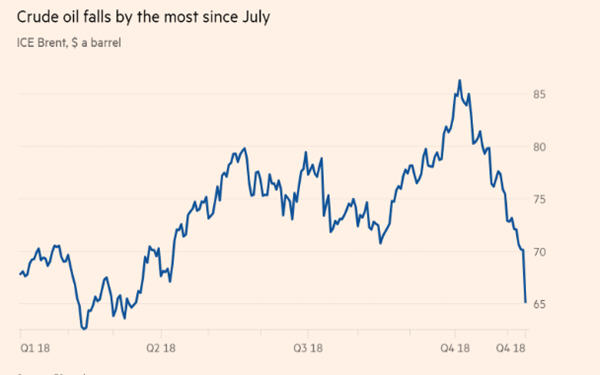
The price of oil bounced back on Wednesday from its worst one-day decline since July, adding to the volatility of a week dominated by fears of a slowdown in global demand.
Brent crude climbed as much as 3.3 per cent in New York to over $67.52 a barrel after falling 6.6 per cent on Tuesday. West Texas Intermediate, the US benchmark, was up as much 2.8 per cent $56.23 after tumbling 7.1 per cent on Tuesday.
After a brief advance on Monday, a gloomier forecast for global demand from Opec’s research arm on Tuesday rattled the market. While the oil price has been in retreat since hitting a four-year high in early October, traders pointed to technical factors in the options markets to explain the severity of Tuesday’s drop.
“When you put all these ingredients together you have a recipe that’s not really conducive to an $85 market environment,” said Michael Cohen, oil analyst at Barclays.
Options on WTI for December delivery are due to settle on Wednesday and large positions remained outstanding for put options conferring the right to sell WTI at $55 a barrel. That gave holders an incentive on Tuesday to drive futures towards that price, and forced options sellers to take short positions to hedge their exposure.
“What you end up with is monster hedging risk,” said Douglas Hepworth of Gresham Investment Management, a commodities fund manager.
The projection from Opec suggested that Saudi Arabia and its partners inside and outside the cartel might be forced to curb supplies to avoid a build-up of oil stocks. Producers are anxious about a slowdown in the world economy, given trade tensions and currency weakness in emerging markets, which Opec said could “pressure” oil demand.
Meanwhile, supply from inside the US continues to rise. The Energy Information Administration on Tuesday estimated that production from shale regions such as the Permian of Texas and New Mexico would reach 7.8m b/d this month, an increase of 117,000 b/d from its previous estimate. For December, the EIA forecast a record 7.9m b/d of shale output.
Brent crude, which topped the $86 a barrel mark on October 3, has now fallen by almost a quarter since then.
The reversal in the price in recent weeks is adding to speculation that Opec will have to trim supply. Khalid al-Falih, Saudi Arabia’s energy minister, said on Monday that Opec and its partners had conducted an analysis that showed that a 1m b/d decline in oil supplies from October levels was required to balance the market.
“We need to do whatever it takes,” said Mr Falih, signalling an impending reversal in oil policy.
In June, Opec and partners outside the cartel had agreed to relax curbs in place since 2017 after pressure from US president Donald Trump. Mr Trump called on Opec and its allies to increase production to offset any declines from Iran after the US reimposed sanctions against Tehran.
Even as Saudi Arabia pledged to raise output towards 11m b/d, a move by the US earlier this month to issue waivers to big buyers of Iranian oil and allow more oil on to the global market has created renewed fears of oversupply. Amid chatter about new supply curbs from producers, Mr Trump took to Twitter this week to again prompt Opec into action, saying “oil prices should be much lower”.
The snowballing losses will cause pain to money managers, who still hold net bullish positions in crude futures equivalent to more than 400m barrels. Some could be required to liquidate their positions after receiving margin calls from brokers.
Source: FT.com